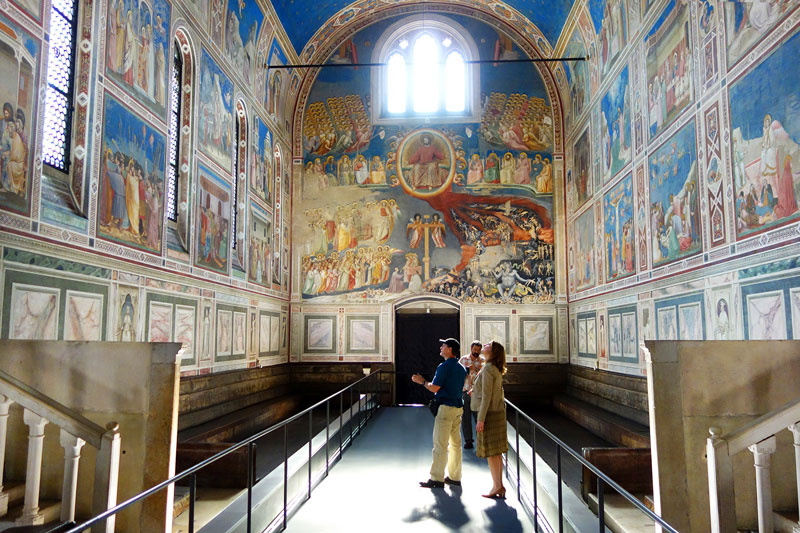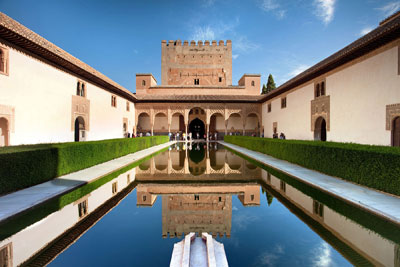What's new in 2015
This item appears on page 48 of the March 2015 issue.
For travelers to Italy, Spain, France, the Netherlands, Belgium, Germany or Austria in 2015, here are a few changes to be aware of.
ITALY
• On the art scene, Florence’s Duomo Museum, with works by Michelangelo and Donatello, is closed for renovation until November 2015.
• In Siena, the Santa Maria della Scala museum is open after an extensive renovation, displaying some of the most ancient Byzantine reliquaries in existence, many made of gold, silver and precious stones. And a new section covers Siena’s history.
• In Padua, you can get 40 minutes inside the Scrovegni Chapel to view Giotto’s marvelous frescoes (instead of the usual 20 minutes) if you pay €4 (near $5) extra and visit during evening hours.
• If you want to see Bolzano’s Ötzi the Iceman — the hiker found entombed in a glacier for 5,000 years — without getting buried in lines, buy your ticket online at least one day in advance, print it, and take it with you to the archaeological museum (www.iceman.it).
• If you’re Romeward-bound, book your hotel room and Vatican Museum tickets early. Pope Francis is a big draw, and, as anywhere, with crowds come pickpockets. Beware of any commotion (even caused by children and pregnant women) in the Metro and anywhere crowds form. Wear a money belt.
• In ancient Rome, the southern part of the boulevard Via dei Fori Imperiali, near the Colosseum, has reopened to traffic. For a while in 2014, the road was a pedestrian zone on weekends and only open to buses, taxis and bikes on weekdays.
SPAIN
• Barcelona’s big news for art lovers is the opening of Casa Lleó Morera (www.casalleomorera.com), which has one of the best-preserved Modernista interiors (from 1906), containing finely crafted mosaics, ceramic work, wooden ceilings and doors, stone sculptures and stained glass. Reservations are required, and access is by tour only.
• Also for Barcelona, the easiest way to get advance tickets for architect Antoni Gaudí’s soaring Sagrada Familía is on the church’s own website (www.sagradafamilia.cat).
• Not far away at Gaudí’s popular Parc Güell (www.parkguell.cat), you now need a timed-entry ticket to enter the Monumental Zone to see the architect’s iconic work: the colorful dragon, grand staircase and wavy-benched view terrace. While the rest of the park is free and wide open, reserve your 7-euro ticket online as far in advance as you can for the Monumental Zone.
• In Madrid’s Royal Palace, the kitchen where the gala dinners were prepared will open to the public, though the royal pharmacy has closed.
• Also in Madrid, the National Archaeological Museum has reopened after a major renovation. It’s like a small British Museum and well worth visiting.
• Toledo’s plan to make the Old Town center essentially traffic-free is taking shape with construction of a new parking lot and escalator that should ease the walk from the train station into town.
• Gibraltar’s monkeys, which congregate at the Apes’ Den on the Rock, have gotten more aggressive, spoiled by being fed for photo ops. Taxi drivers have been warned to stop feeding them.
• In Córdoba, the brand-new high-tech Museo Taurino Córdoba pays tribute to the city’s bullfighting tradition, with displays on bull-raising, bullfighters and the aesthetics of the fight (though similar museums in Ronda and Sevilla are better).
• In Granada, if you want to see the famous Moorish palace at the Alhambra on short notice, the easiest solution is to buy the pricey Bono Turistico city pass, which even at the last minute (sometimes even the same day) lets you choose virtually any entry time to the complex.
FRANCE
• In Paris, the Picasso Museum (www.museepicassoparis.fr) has finally reopened after years of renovation. Because of all the hype surrounding its remodel, book tickets online in advance to avoid the lines. (Note: It’s no longer covered by the Paris Museum Pass.)
• The Louvre’s iconic pyramid entrance is under renovation until 2016. During this time, expect signage to point the way to the best entrance for visitors to use.
• To avoid the long ticket line at the Orsay Museum, purchase tickets (or a Paris Museum Pass) at the newspaper kiosk outside the museum, on the steps below the passholder entry (Entrance C). From the Orsay, you now can stroll or bike the new Left Bank riverside promenade that stretches to Pont de l’Alma.
• At the Eiffel Tower (www.toureiffel.paris), the first level has a new glass floor, theater, eateries, and exhibits describing the tower’s construction. A champagne bar has opened on the very top floor. Online ticketing has gotten more convenient, with an option to download a ticket to your mobile phone — no paper ticket needed.
• In Chantilly, the recently renovated horse museum has a beautiful display of equine-related history and art. Museum entry includes a walk through the stables and a dressage demonstration daily in peak season. Horse lovers can pay extra for an equestrian show with riders in frilly outfits and horses prancing to music.
• In Rouen, a new Joan of Arc Museum — featuring various multimedia displays about the country’s 15th-century heroine — opened in February next to the cathedral, at the site of her trial and conviction.
• At the Airborne Museum in Normandy’s Ste-Mère Église, a new third wing gives visitors a chance to virtually experience a paratrooper’s D-Day night jump.
• In the Dordogne region, the Grotte de Font-de-Gaume, the famous cave with multicolored prehistoric paintings, is getting harder to visit. Entry is by guided tour, and only 78 visitors are admitted per day. Of these, only 26 spots per day can be reserved in advance (email fontdegaume@monuments-nationaux.fr). The remaining 52 tickets are sold on a same-day basis. If you want to visit in summer, arrive at the crack of dawn to be first in line.
• In Provence, the Fondation van Gogh in Arles has moved into its newly restored permanent home, with exhibits on van Gogh and contemporary artwork that pays homage to the Dutch artist. A fun feature of the building is the kaleidoscopic glass rooftop sculpture by artist Raphael Hefti.
THE NETHERLANDS
• In the Netherlands, paper tickets for domestic train travel are a thing of the past. Instead, the Dutch now use a transit smartcard on trains, buses and trams all over the country. Most tourists will still be buying single train tickets, called “disposable” chip cards.
• Amsterdam’s Van Gogh Museum will open a new glass-walled pavilion entrance onto Museum Square (Museumplein) in the summer of 2015. The museum is extending evening hours until 10 o’clock on Saturdays in July, August and October as well as staying open as usual on Friday nights from March through October.
• The Amstelkring Museum (a once-hidden church, dating from the days when public Catholicism was prohibited), in Amsterdam’s Red Light District, is undergoing an extensive renovation, due to wrap up in late 2015.
• In The Hague, the Mauritshuis Royal Picture Gallery has reopened, after a lengthy renovation, with greatly increased exhibition space. The collection of Dutch Golden Age art includes top-notch pieces by Rembrandt, Rubens and Vermeer (his famous “Girl with a Pearl Earring” lives there).
BELGIUM
• In Belgium, Antwerp’s new Red Star Line Museum fills the hall that processed many of the two million emigrants who passed through the city on their way to the New World.
• Ghent recently introduced its new City Market Hall, a social hub partially sheltered by a modern, twin-gabled timber roof in the heart of town.
• The new Bruges Beer Museum (www.brugesbeermuseum.com) is an ode to beer’s frothy history, including tastes from a rotating list of local drafts.
GERMANY
• While trains are usually the easiest way for Americans to get around Germany, ultracheap buses are a new option worth considering. The main bus lines are MeinFernBus (with the most extensive network), FlixBus, Berlin Linien Bus and City2City. Taking you across much of Germany for around €15 ($18) — and using train stations as starting and ending points — they can be a great value.
• In Munich, the new Egyptian Museum (near the main train station) is well worth a visit. It’s custom-built to evoke the feeling of being in an ancient tomb.
• Munich’s new Nazi Documentation Center (located near Königsplatz, on the site of the former Nazi Party headquarters) will cover the rise and fall of Nazism, with a focus on the city’s role. It’s slated to open on April 30, the 70th anniversary of Munich’s liberation from Nazi rule.
• Also in Munich, both the Halls of the Nibelungen in the Residenz palace and the Frauenkirche’s iconic twin towers are closed in 2015.
• In Frankfurt, the Museum Judengasse will be closed until at least the fall of 2015. Located next to the Jewish Cemetery and Holocaust Memorial, the museum includes a data-bank record on each Frankfurt Jew deported and murdered by the Nazis.
• Koblenz, the site of the Deutsches Eck (the patriotic spot where the Rhine and Mosel rivers converge), is home to the new Forum Confluentes, a modern cultural center/art museum that also houses a library and restaurants.
• On the Rhine near the town of St. Goar, the Loreley Visitors’ Center has closed and is not likely to reopen.
• In Trier, a new hop-on, hop-off bus tour covers the amphitheater, the basilica and Karl Marx’s house before venturing to Petrisberg for great views over Trier and the Mosel Valley.
• In Nürnberg, the Historic Art Bunker has opened to the public. It’s a series of cellars deep inside the rock of Castle Hill, where precious artwork was carefully safeguarded from the WWII air raids that devastated the city. The only way to visit the now-nearly-empty bunker is on a once-daily tour (in German, but the good audio guide is in English).
• Wittenberg’s Castle Church (where Luther nailed his Ninety-Five Theses) is being renovated and should be open again in early 2017, in time for the 500th anniversary of the start of the Reformation.
• Dresden’s Royal Palace, destroyed during World War II, is currently being rebuilt, with galleries opening to the public as they are completed.
• In Berlin, the famous Pergamon Altar at the Pergamon Museum will be off-limits to visitors until 2019 as the museum undergoes major renovation (but its Babylonian Ishtar Gate still makes the museum worth a visit).
AUSTRIA
• In Austria, Vienna has finished building an impressive new main train station, the Hauptbahnhof, in the location of the former Südbahnhof. Most trains depart from the new station, though some trains still leave from the city’s other stations.
• To save money on the popular route between Vienna and Salzburg, consider the private Westbahn rail service, which charges half the price of the state-run trains. It’s currently based in the Westbahnhof but may move its service to the Hauptbahnhof; check when booking.
• The Vienna Boys’ Choir has another venue for performances: MuTh, a concert hall in the Augarten public park, which also hosts shows by the Vienna Children’s Theater plus children’s operas, classical concerts and pop music. The Boys’ Choir performs there on Friday afternoons in September and October.
• Between Vienna and Salzburg, the Mauthausen Concentration Camp Memorial now has free admission. The museum (in a barracks within the camp) was recently renovated and presents a chronological history in English, including stories of camp inmates and Nazi officers, along with bone-chilling artifacts.
• Salzburg has packaged some of its central Old Town sights into a single 12-euro ($14.50) ticket called the DomQuartier ticket, covering sights at the Residenz, Cathedral, St. Peter’s Abbey Museum and Franziskanerkirche.
• In Reutte, a new 1,200-foot-long pedestrian suspension bridge now links Ehrenberg Castle with the difficult-to-reach Fort Claudia across the valley. The bridge soars more than 300 feet above the valley floor.
Happy travels!


